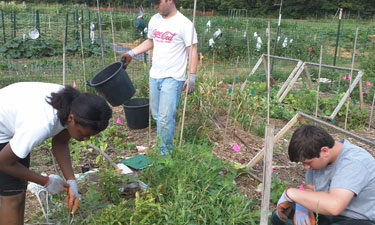 The family farm, an iconic piece of the American landscape, is becoming a fading memory. In recent decades, expansive urbanization and economic forces have led to small-farm selloff for residential and commercial development and the establishment of mega farms. Today’s youth have little knowledge of or experience with agriculture. Farmland has been diminishing at an alarming rate, but there is an agricultural renaissance underway. Park and recreation agencies and districts are partnering with the farming community to preserve agricultural heritage, promote conservation and provide education programming that reconnects urbanites with rural America. It’s a natural fit. Whether you are in an urban, suburban, county or special park district, the connection with the agricultural community is relevant and important. The interface between parks and recreation and agriculture occurs on various levels, including community engagement and education, conservation of natural resources and the agritourism economy.
The family farm, an iconic piece of the American landscape, is becoming a fading memory. In recent decades, expansive urbanization and economic forces have led to small-farm selloff for residential and commercial development and the establishment of mega farms. Today’s youth have little knowledge of or experience with agriculture. Farmland has been diminishing at an alarming rate, but there is an agricultural renaissance underway. Park and recreation agencies and districts are partnering with the farming community to preserve agricultural heritage, promote conservation and provide education programming that reconnects urbanites with rural America. It’s a natural fit. Whether you are in an urban, suburban, county or special park district, the connection with the agricultural community is relevant and important. The interface between parks and recreation and agriculture occurs on various levels, including community engagement and education, conservation of natural resources and the agritourism economy.
Community Engagement and Education
Almost 10,000 farmers markets are operating in the U.S. today. Farmers markets are becoming a mainstay operation for an increasing number of park and recreation agencies. The obvious benefit of supporting local meat, vegetable, fruit and herb producers meets a growing demand for fresh, healthy food choices. Farmers markets now offer nutritious food sources for those eligible for the federal Supplemental Nutrition Assistance Program. Park and recreation agencies that offer community garden programs can also provide farmers markets with their bounty. The new Farm Bill gives park and recreation agencies the opportunity to partner with the local school district as part of the Farm to School program.
Conservation of Natural Resources
Farmers are conservationists. Conservation is a pillar of sustainable agriculture in the U.S. Park and recreation agencies also have a conservation mission, and there are opportunities to partner with farm owners to protect natural resources. Stream corridors shared by a farm and public park land can be protected through a cooperative agreement. Park and recreation agencies and districts use lease agreements, conservation easements or fee-simple purchases to protect adjacent farmland and natural resources, as well as preserve agricultural heritage. The agricultural land can be actively farmed using conservation practices such as stream buffers, grassed waterways and conservation tillage.
Agritourism Economy
To reconnect with the agricultural past, agritourism has become a popular and lucrative enterprise. Agritourism can be defined as any activity on a farm that is operated for recreational, educational and cultural purposes. Park and recreation agencies operate demonstration farms, interpreting farm life and engaging children and families in the rich history of agriculture. Agritourism is also a good revenue generator for a park system.
Two park districts in southwestern Ohio are at the forefront of the agriculture and parks movement.
Miami County Park District (MCPD) and neighboring Five Rivers Metro Parks (FRMP) in Montgomery County near Dayton incorporate agriculture into their operations and programs, preserving the agricultural heritage of the region. Miami County Park District features the Knoop Agricultural Heritage Center and a working farm at its Lost Creek Reserve, a valuable resource for interpreting the farm life practiced by the families that settled the area. The Fall Farm Fest at Lost Creek Reserve celebrates the region’s agriculture heritage. The Park District also received assistance through programs in the Farm Bill to protect wildlife habitat and riparian corridors.
Five Rivers Metro Parks has developed a comprehensive program focusing on agriculture. The agency operates a farmers market, engages youth in agriculture programs and employs conservation practices. As FRMP began acquiring land to build its park system, agriculture modernization in the early 1960s made farmland available for sale. FRMP added thousands of acres of parkland by outright purchase or conservation easements on farmland. Preserving the community’s agricultural heritage is aligned with the agency’s mission of conservation, education and recreation. FRMP established Possum Creek and Carriage Hill as farm parks to connect people to nature through history, farming and food. Carriage Hill immerses visitors in the farm experience.
These are just two examples of the growing number of park and recreation agencies that are integrating agriculture into their operations and programming. NRPA’s Parks and Conservation Network would like to hear about your agency’s or district’s experience with the agriculture community.
Mark Alan Young is a consultant with Parks Forever Consulting.

